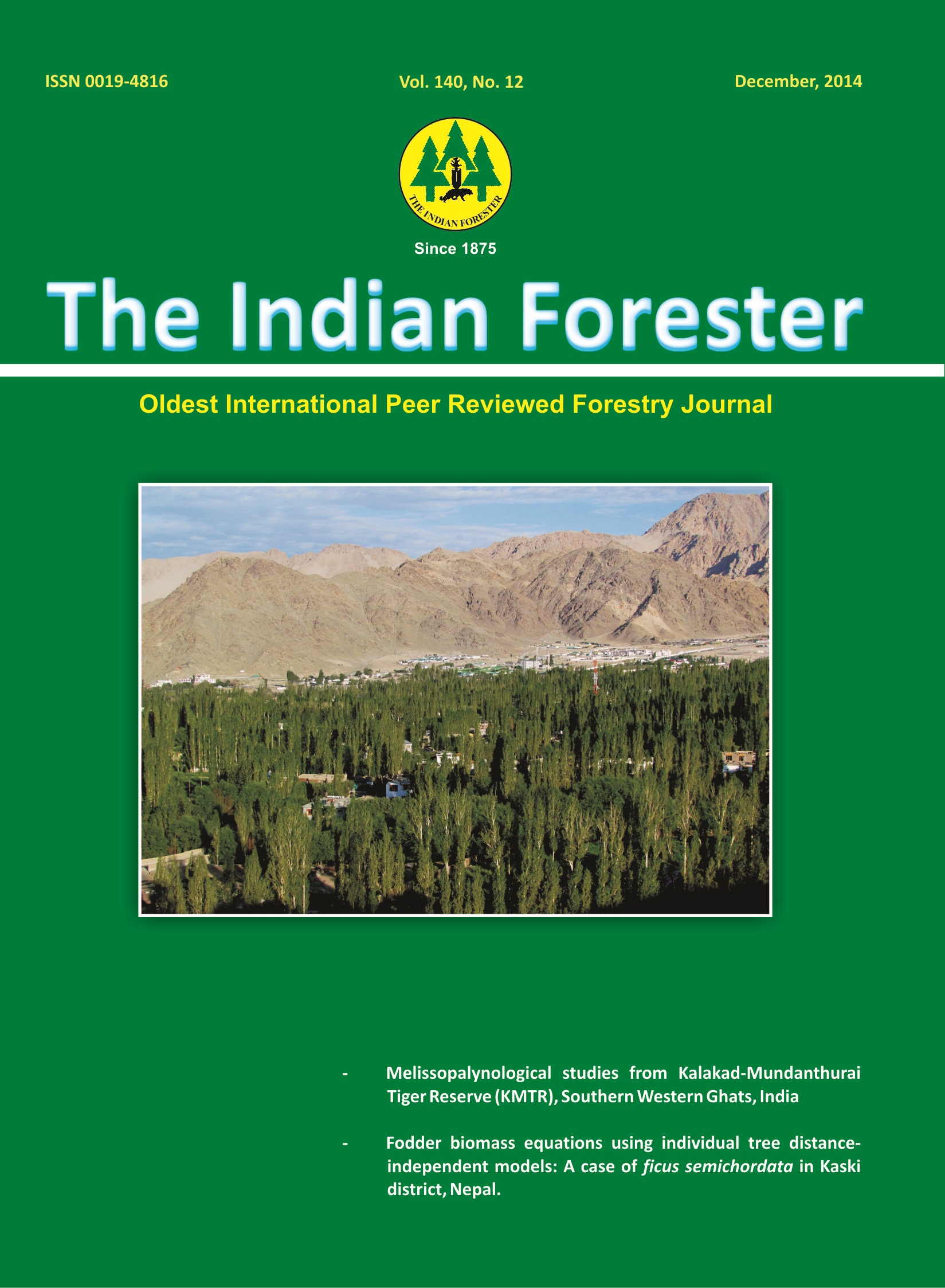Phytosociological Studies in the Dry Red Sanders (pterocarpus santalinus L. f.) Bearing Forest Areas of Eastern Ghats, Andhra Pradesh
DOI:
https://doi.org/10.36808/if/2014/v140i12/55263Keywords:
Floristic Composition, Community Structure, Quantitative Diversity Assessment, Species DiversityAbstract
An intensive study was conducted to quantitatively assess the composition and structure of vegetation in the dry red sanders (Pterocarpus santalinus L. f.) bearing forest areas of Eastern Ghats, Andhra Pradesh. A total of 243 stems (≥10 cm dbh) belonging to 40 tree species and 21 families were enumerated in 45 quadrats of 100 m<SUP>2</SUP> each, spread over five study sites. Tree communities at the five sites differed in composition, density, dominance and structure. The number of species (species richness) across study sites ranged from 5 to 20. The tree density across study sites ranged from 622.2 stems ha<SUP>-1</SUP> to388.9 stems ha<SUP>-1</SUP> . The basal area across study sites ranged from 15.884 m<SUP>2</SUP> ha<SUP>-1</SUP> to 7.351 m<SUP>2</SUP> ha<SUP>-1</SUP> . The Shannon-Weiner Index (H') of species diversity varied from 2.765 to 1.414. Syzygium alternifolium, Anogeissus latifolia and Chloroxylon swietenia were found to be the predominant species at the study sites. The relative position of red sanders in the community was found to be fifth and beyond.Red sanders was conspicuously absent from the higher diameter classes. The probable cause for this absence and its implications are discussed.References
Anony.(2006). Biodiversity characterization at landscape level in Eastern Ghats using Satellite Remote Sensing and Geographic Information System.Technical report, Department of Space and Department of Biotechnology, Government of India.
Champion H.G. and Seth S.K. (1968). A revised survey of the forest types of India.Government of India Press, Nasik, 404 pp.
Condit R., Hubbell S.P. and Lafrankie J.V.(1996). Species-area and species-individual relationship for tropicaltrees: A comparison of three 50- ha plots. Ecology, 84: 549-562.
Curtis J.T. (1959). Vegetation of Wisconsin.An ordination of plant communities.University of Wisconsin Press, Madison, Wisconsin.
Ferreira L.V. and Prance G.T. (1998). Species richness and floristic composition in four hectares in the Jau NationalPark in upland forests in central Amazonia.Biodiversity and Conservation, 7: 1349–1364.
Frankie G.W., Baker H.G. and Opler P.A. (1974). Comparative phenological studies of trees in tropical wet and dryforests in the lowlands of Costa Rica. The Journal of Ecology, 62: 881-919.
Gentry A.H. (1992). Tropical forest biodiversity: Distributional patterns and their conservation significance. Oikos, 63: 19-28.
Ghate U., Joshi N.V., and Gadgil M.(1998). On the pattern of tree diversity in the Western Ghats of India.Current Science, 75:594-603.
Hijmans R.J., Cameron S.E., Parra J.L., Jones P.G. and Jarvis A. (2005). Very high resolution interpolated climate surfaces for global land areas. International Journal of Climatology, 25: 1965-1978.
Kennard D.K., Gould K. and Putz F.E.(2002).Effect of disturbance intensity on regeneration mechanisms in atropical dry forest.Forest Ecology and Management, 162: 197-208.
Kimmins J.P. (1997). Biodiversity and its relationship to ecosystem health and integrity. Forest Chronicle, 73: 229-232.
Kumar A., Gupta A.K. and Marcot B.G. (2002).Management of forests in India for biological diversity and forest productivity, a new perspective. Volume IV: Garo Hills Conservation Area (GCA). Wildlife Institute of India – USDA Forest Service collaborative project report, Wildlife Institute of India, Dehra Dun, India, 206 pp.
Magurran A.F. (1988). Ecological diversity and its measurements. University Press, Cambridge.
Murphy P.G. and Lugo A.E. (1986). Ecology of tropical dry forest. Annual Review of Ecology and Systematics, 17: 67-88.
NRSA. (1998). Biodiversity characterization at landscape level using remote sensing and GIS. Field manual, National RemoteSensing Agency, Hyderabad, India.
Philips E.A. (1959). Methods of vegetation study.Henri Holt Co. Inc., New York.
Phillips O.L., Martinez R.V. and Vargas P.N. (2003).Efficient plot-based floristic assessment of tropical forests.Journal of Tropical Ecology, 19: 629-645
Pitman, N.C.A., Terborgh, J.W. and Silman, M.R. (2002).A comparison of tree species in two upper Amazonianforests.Ecology, 83: 3210- 3224.
Reddy C.S., Babar S., Giriraj A., Reddy K.N. and Rao K.T. (2008). Structure and floristic composition of tree diversity in tropical dry deciduous forest of Eastern Ghats, Southern Andhra Pradesh, India.Asian Journal of Scientific Research, 1(1): 57-64.
Sukumar R., Dattaraja H.S. and Suresh H.S. (1992).Long-term monitoring of vegetation in a tropical deciduousforest in Mudumalai, southern India.Current Science, 62: 608-613.
Downloads
Downloads
Published
How to Cite
Issue
Section
License
Unless otherwise stated, copyright or similar rights in all materials presented on the site, including graphical images, are owned by Indian Forester.





